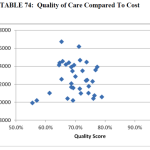Over the past year I have often written about the CMS incentive programs that impact nephrologists. Meaningful use, PQRS and eRx are frequent topics of this blog. Each of these programs uses a “carrot and stick” financial incentive to modify physician behavior. In each case the incentives are paid (or extracted) based on reporting data to CMS. That is to say, these programs are classic pay-for-reporting (P4R) programs. Both the PQRS program and the meaningful use clinical quality measures within the EHR Incentive program require the participant to submit quality data to CMS; however, the incentive is not tied to your performance. It is only based on reporting the data. The one exception is the recent change to PQRS, which prevents payment if a measure’s performance score is zero. Not an unreasonable change.
The CMS ESRD Quality Incentive Program is the first true pay-for-performance (P4P) program nephrologists may encounter. Last week CMS announced results for the program’s first year. Few nephrologists will be directly impacted by this program, the exception being nephrologists involved in joint ventures with dialysis organizations as well as those who are independent facility owners. However, in spite of the lack of widespread direct involvement from a financial perspective, there will certainly be a halo effect for the majority of practicing nephrologists. Each facility’s score, for example, will be physically posted in a publically accessible location within the facility. The scores will also be available on the dialysis compare web site. There is a decent chance you will have the opportunity to explain the score your facility obtained to a patient or a family member.
The approach CMS has taken with this program warrants our attention. While touted as a P4P program by CMS, many would argue this is actually a “penalize for lack of performance” program. There were no incentives paid to facilities with outstanding performance, only penalties which will be levied against facilities that underperformed. In light of this nuance, some consider this program simply a “holdback” imposed by Medicare.
Of additional interest is the timing of the program. The penalties that will be levied in 2012 are based on the facilities’ performance in 2010 in comparison to baselines established in either 2008 or 2007. Talk about confusing! Finally, it has been interesting to observe this process from the outside. Stakeholders in the renal community (like Amgen) appear to have had had some influence over the weighting of the anemia measures. With the controversy swirling around the use of ESAs in this patient population, one might ask if CMS is nimble enough to modify quality targets in a timely fashion as new standards of care emerge based on clinical studies.
I think there are a few lessons here for the practicing nephrologist:
- CMS is very serious about value-based purchasing.
- The P4R schemes we have faced in the past will likely evolve into P4P programs in the future.
- We can learn a great deal about CMS’s intentions from the QIP program, and we should pay close attention as this program matures.
Pay for performance is always a controversial topic in healthcare. We’d love to hear your comments related to QIP and P4P. In the meantime, I hope you and your families enjoy a safe and prosperous holiday season.




Randy Gertner says
My understanding is that the “target” is a hgb of 10-12 for this program. This will apply for 2012, based on data from 2010. However, I read somewhere that in 2013 this goal goes away, because of the new guidelines (in the package insert) regarding ESAs. Now, there is a recommendation by the FDA that there is no target. We should use the lowest dose that will avoid a blood transfusion. It is disheartening that we are being penalized to follow the wrong goal. There is a major buzz among the dialysis staff about “getting that hgb above 10.” I think this comes from this new penalty program. Although this was changed for 2013, I think it should have been changed in the final rule for 2012. If the physician and dialysis are held accountable, someone should hold the rule makers accountable for approving a rule that the FDA now no longer says is applicable.